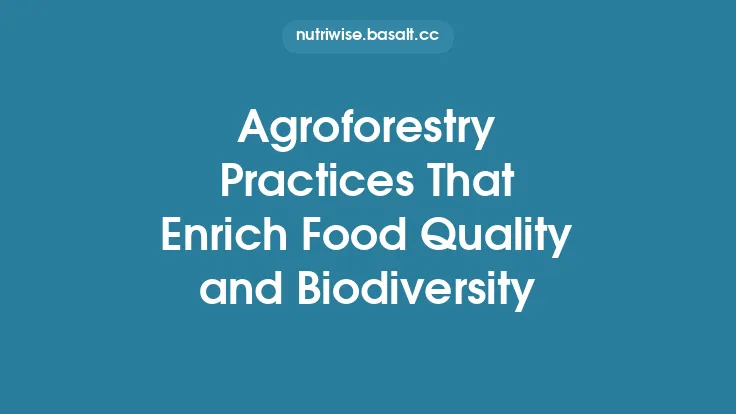Indigenous food biodiversity represents the vast array of plant, animal, fungal, and algal species that have been cultivated, harvested, and managed by Indigenous peoples for generations. This diversity is not merely a catalog of edible organisms; it embodies intricate ecological relationships, centuries‑old selection practices, and a deep understanding of how each species contributes to the nutritional tapestry of traditional diets. By examining the breadth of this biodiversity and the nutritional attributes it offers, we can appreciate how Indigenous food systems have historically provided balanced, resilient sources of sustenance.
Defining Indigenous Food Biodiversity
Indigenous food biodiversity can be parsed into three interrelated dimensions:
- Species Diversity – The total number of distinct edible species present within a cultural region, ranging from staple grains and tubers to wild greens, berries, nuts, insects, and aquatic organisms.
- Genetic Diversity – The variation found within a single species, manifested in landraces, cultivars, and ecotypes that differ in traits such as drought tolerance, flavor, and nutrient composition.
- Ecological Diversity – The variety of habitats (forests, wetlands, grasslands, coastal zones) that support different food species, each contributing unique nutritional profiles.
These dimensions collectively shape the food options available to a community and influence the overall nutrient intake of its members.
Taxonomic and Genetic Diversity in Indigenous Food Systems
Indigenous peoples have historically selected and maintained a wide taxonomic spectrum:
- Angiosperms – Including cereals (e.g., teosinte relatives), legumes (various *Phaseolus and Vigna species), tuberous roots (Manihot, Ipomoea), and leafy greens (Amaranthus, Chenopodium*).
- Gymnosperms – Such as pine nuts (*Pinus* spp.) and other conifer seeds.
- Fungi – Edible mushrooms (*Agaricus, Pleurotus*) and truffles that thrive in symbiosis with tree roots.
- Animal Kingdom – Small mammals, birds, fish, crustaceans, and insects (e.g., grasshoppers, beetle larvae) that have been incorporated into diets.
- Algae – Freshwater and marine macroalgae (e.g., *Ulva, Porphyra*) harvested from coastal and riverine environments.
Within each taxon, genetic diversity is preserved through practices such as seed saving, selective planting, and controlled wild harvest. For example, multiple landraces of a single grain may differ in protein content, mineral uptake efficiency, or resistance to local pests, thereby offering a spectrum of nutritional outcomes.
Nutritional Profiles Across Diverse Species
The nutritional contribution of Indigenous food biodiversity can be categorized by macronutrients, micronutrients, and bioactive compounds.
Macronutrients
- Carbohydrates – Starchy tubers and grains provide complex carbohydrates with varying glycemic indices. Some wild tubers contain higher resistant starch, which can modulate post‑prandial glucose response.
- Proteins – Legumes, nuts, seeds, and certain insects supply essential amino acids. The amino acid profile of insect protein often mirrors that of animal meat, offering high lysine and methionine content.
- Fats – Oil‑rich seeds (e.g., *Sacha Inchi, Pili*) and nuts contribute unsaturated fatty acids, including omega‑3 (α‑linolenic acid) and omega‑6 (linoleic acid) ratios favorable for cardiovascular health.
Micronutrients
- Vitamins – Wild leafy greens are notable sources of vitamin A (β‑carotene), vitamin C, and B‑complex vitamins. Certain berries deliver high levels of vitamin K and folate.
- Minerals – Roots and seeds often accumulate iron, zinc, calcium, and magnesium. For instance, the mineral density of wild amaranth leaves can exceed that of cultivated spinach, particularly in iron and calcium.
- Trace Elements – Some edible fungi concentrate selenium and copper, while marine algae are rich in iodine and trace amounts of chromium.
Bioactive Compounds
Indigenous foods frequently contain phytochemicals such as polyphenols, flavonoids, and alkaloids that possess antioxidant, anti‑inflammatory, and antimicrobial properties. The phenolic content of wild berries, for example, can be several times higher than that of commercially cultivated varieties, contributing to a higher total antioxidant capacity.
Micronutrient Richness and Bioavailability
The mere presence of micronutrients does not guarantee their absorption. Indigenous food systems often incorporate preparation methods that enhance bioavailability:
- Fermentation – Fermented fish or maize products can reduce antinutritional factors (e.g., phytates) that otherwise inhibit mineral absorption.
- Soaking and Sprouting – These processes activate endogenous enzymes, increasing the availability of iron and zinc from legumes and seeds.
- Cooking with Fat – Pairing fat‑soluble vitamins (A, D, E, K) from leafy greens with oil‑rich seeds improves their uptake.
Such techniques, refined over generations, reflect an empirical understanding of nutrient dynamics without formal scientific terminology.
Role of Biodiversity in Dietary Diversity
A diverse food base mitigates the risk of nutrient deficiencies by providing multiple sources for each essential nutrient. When one species experiences a seasonal decline or environmental stress, alternative species can fill the nutritional gap. This redundancy is a hallmark of resilient dietary patterns and is evident in many Indigenous communities where a single meal may combine grains, legumes, greens, nuts, and animal protein.
Moreover, the inclusion of a broad spectrum of flavors, textures, and aromas encourages varied consumption patterns, which can prevent monotony and promote higher overall food intake—a factor linked to adequate energy and nutrient provision.
Ecological Interactions Supporting Nutrient Content
The nutritional quality of many Indigenous foods is directly linked to their ecological context:
- Mycorrhizal Associations – Certain edible mushrooms form symbiotic relationships with tree roots, facilitating the exchange of carbon and minerals. This interaction can increase the concentration of selenium and potassium in the fruiting bodies.
- Nitrogen‑Fixing Legumes – Leguminous plants enrich soil nitrogen, which not only benefits the legumes themselves but also neighboring crops, indirectly influencing protein content across the food system.
- Aquatic Food Chains – Fish and shellfish accumulate omega‑3 fatty acids through the consumption of algae and plankton, making them valuable sources of essential fatty acids in coastal Indigenous diets.
Understanding these ecological linkages underscores how biodiversity is not a static inventory but a dynamic network that shapes nutrient composition.
Case Studies of Biodiversity in Specific Regions
The Andean Highlands
In the Andean region, a mosaic of tubers (e.g., *Oca, Mashua, Yacon) coexists with quinoa (Chenopodium quinoa) and a variety of wild greens (Lupinus spp., Tarwi). Each tuber exhibits distinct carbohydrate structures and mineral profiles; for instance, Yacon stores fructooligosaccharides that function as prebiotic fibers, while Oca* is rich in potassium.
The Pacific Northwest
Coastal Indigenous groups harvest a suite of marine resources—salmon, shellfish, seaweed—alongside terrestrial foods such as huckleberries, camas bulbs, and pine nuts. Seaweed (*Nereocystis* spp.) provides iodine and vitamin B12, complementing the iron and vitamin D supplied by salmon.
The Australian Outback
Aboriginal communities utilize native seeds (e.g., *Macadamia, Wattleseed), fruits (e.g., Bush Tomato*), and insects (e.g., witchetty grub). Wattleseed, a legume, offers a high protein content with a favorable amino acid balance, while the witchetty grub supplies a dense source of protein and essential fatty acids.
These regional examples illustrate how biodiversity translates into a spectrum of nutrients tailored to local environmental conditions.
Challenges to Maintaining Food Biodiversity
Despite its importance, Indigenous food biodiversity faces several pressures:
- Habitat Loss – Land conversion for agriculture, mining, or urban development reduces the availability of wild food habitats.
- Genetic Erosion – The replacement of traditional landraces with high‑yield commercial varieties can diminish genetic variability.
- Climate Variability – Shifts in temperature and precipitation patterns affect the phenology and distribution of many edible species.
- Market Integration – Increased reliance on imported foods can lead to the abandonment of traditional foraging and cultivation practices.
Addressing these challenges requires collaborative efforts that respect Indigenous stewardship while integrating contemporary conservation science.
Future Directions for Research and Documentation
To deepen our understanding of Indigenous food biodiversity and its nutritional value, several research avenues merit attention:
- Comprehensive Nutrient Databases – Systematic analysis of macro‑ and micronutrient composition across a wide range of Indigenous foods, including under‑studied wild species.
- Genomic Characterization – Sequencing of landraces and wild relatives to identify genes linked to nutrient density, stress tolerance, and flavor.
- Metabolomic Profiling – Mapping bioactive compounds to elucidate health‑related properties beyond basic nutrition.
- Ethnobotanical Mapping – Documenting traditional knowledge of species use, seasonal availability, and preparation methods to preserve cultural context.
- Ecological Modeling – Predicting how environmental changes may impact the distribution and nutrient content of key food species.
By integrating interdisciplinary approaches—nutrition science, genetics, ecology, and anthropology—future work can safeguard the richness of Indigenous food biodiversity for generations to come.





